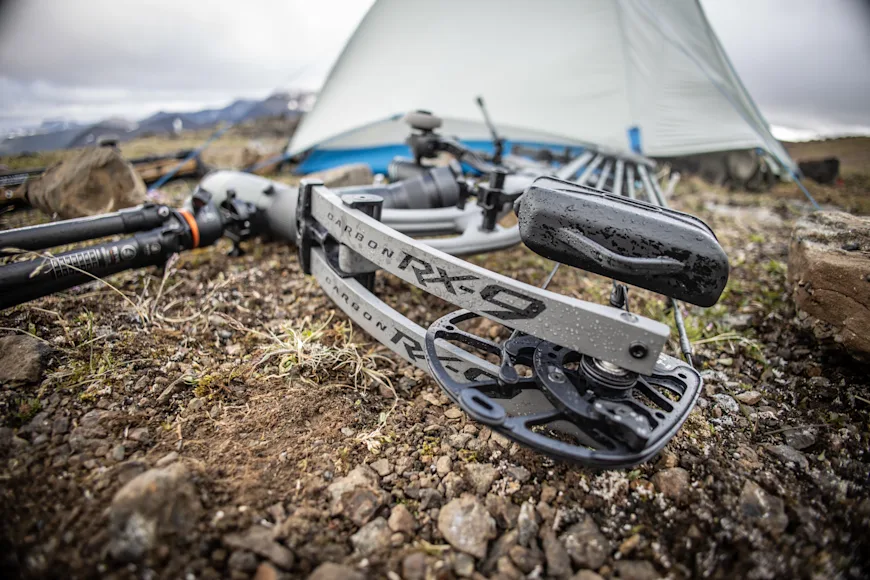As with most years, Hoyt has rolled out new flagship bows in both its carbon-riser and aluminum-riser lines for 2025. But because the company is best-known for its carbon builds—and has pretty much dominated that arena ever since it introduced the original Carbon Matrix in 2010—we are testing the new Carbon RX-9 first.
I have, as a matter of fact, tested every single carbon-riser bow Hoyt has brought to market since the first one, and I've hunted with most, too. My impression from the beginning has been that Hoyt's carbon bows are durable, accurate, lightweight, and quiet. I didn't expect the new RX-9 line to be any different, and to find out I put one of the new flagship models to the test on my home range and in the field.
The new-for-2025 Carbon RX-9 line includes three models—the RX-9 (30 1/2-inch) and RX-9 Ultra (33 1/2-inch) and the RX-9 SD (Short Draw). I requested a test bow, and the one that arrived on my doorstep was the RX-9 Ultra. As noted above, the Ultra model is longer from axle-to-axle; it also has a slightly extended brace height, and allows for draw lengths up to 31 inches. Below is my full review, including how I set up and tested the bow, and how it fared in the end.
Hoyt RX-9 Ultra Specs

Axle-to-Axle Length: 33 1/2"
Brace Height: 6 3/8"
Weight: 4.3 lb.
Draw Length: 26-31"
Max Draw Weight: 40, 50, 60, 70, or 80 lb.
Advertised Speed: 340 fps (ATA)
MSRP: $2,149
Hoyt Carbon RX-9 Ultra Overview

The new RX-9 comes with an upgraded HBX Gen 4 cam system that offers 1/4-inch draw-length adjustments (no bow press needed), as well as an adjustable let-off (70, 75, and 80 percent) via a single set screw in the cable stop arm. You can set the bow for a Hard or Xtra Hard backwall, which is an option I really appreciate. The integrated cam kickstand on the top and bottom is back; it elevates the cam off the ground, keeping the groove free of dirt and debris.
Compared to last year's RX-8 Ultra, I noticed slightly wider yet thinner limb pockets with narrower struts. Hoyt engineers chose narrower struts to accept new TXL limbs, which are shorter than the limbs on the RX-8. The pocket system looks tight, and the limb-to-riser attachment is clean and sleek—not bulky like some limb pockets can be.
Hoyt's In-Line Accessory system includes a Picatinny rail on the front of the riser and IMS dovetail slits in the back of the riser accept modern-day sight and drop-away rest options. The riser sports an upper and lower stabilizer mounting hole, and the strings and cables showed no frays or nicks. Hoyt's strings and cables are solid. Not great, but solid. Mine lasted nearly five months before I started getting peep rotation.
RX-9 Ultra Bow Build

My test bow came with a draw length of 28.75 inches, and I needed to change it to 29, which was easy to do. I just removed a pair of screws, adjusted the cam module, and reinserted the screws. Hoyt, like many compound makers, uses a letter system for draw-length guidance. A reference guide is available when you scan the QR code that comes with the bow. I appreciate being able to make 1/4-inch draw-length adjustments.
I used my digital bow scale to measure the bow's exact draw weight. Hoyt bows tend to run heavy, which was the case with the RX-9 Ultra. The 70-pound draw-weight bow measured 72.8 pounds on the digital scale, so I backed it off. Draw weight adjustment was also a breeze, and the limb bolts on the RX-9 Ultra are extremely smooth—there is no chatter or pooping. This is a surefire indicator of an excellent pocket-to-riser connection. I got the bow to 70.11 pounds on my scale.
The bow pressed easily, peep insertion was simple, and though I had to make some adjustments, proper timing was generally easy. The top cable stop contacted the inner cable slightly before the bottom. I typically time Hoyt bows this way. I set up Easton's all-new 5.0 arrows with four Flex-Flech Pro 2.5 vanes, 100-grain field points, HIT inserts, HIT collars, and 5mm Microlite nocks. The total arrow weight was 381.5 grains.
The RX-9 Ultra On The Range

A bow's grip is important when shooting, so I save my evaluation of this for the range. The RX-9 Ultra's grip is slim, flat-backed, and direct-to-riser, allowing me to get the meaty part of my palm into the grip. I hate when a bow forces you to get too much of your hand into the grip. This one does a good job of preventing you from adding torque.
The draw is generally smooth. You feel the weight at the front end of the cycle, but as you near let-off, the weight builds evenly. The transition to my choice of 80 percent let-off was generally smooth. I don't like a really hard back wall. For this reason, I went with the Hard, as opposed to Xtra Hard, backwall option. Both options will contact the bow's inner cable, but the two walls have a distinct difference. As a handheld release shooter, I prefer to pull into my cables, feeling a slight valley. The feel of the Hard backwall was just right for me. The bow sits still in the hand, and the cams aren't inching forward trying to pull you into the shot. I was able to relax and let the pin float while focusing on letting the release fire the bow.
The RX-9 Ultra consistently produced sub-1-1/2-inch groups from 40 yards. It was one of the most accurate bows I've tested so for for 2025. The bow has an uncanny ability to help the archer acquire the target quickly. This bow holds and aims incredibly well. The 6-3/8-inch brace height is forgiving. Several times, after shooting dozens and dozens of arrows, I was sure a given arrow would be off the mark when the release broke. But it rarely was.
I actually felt increasingly confident with this bow the farther I moved from the target. On the last day of testing, I shot my home 3-D course. No shot was taken under 60 yards, and 10 of the 12 shots were beyond 70 yards. My final score out of a possible 120 points was 115. I hit a 5 on the 68-yard Rinehart Javelina, but I made up for the error from 76 yards with a 14 on the Delta McKenzie Mule Deer. The bow is nearly 100 percent dead in hand. I could detect a slight hand tickle if I paid ultra-close attention. The bow is also nice and quiet.
Hoyt RX-9 Final Tune
When testing the newest compound bows, a final tune is one of the last things I do before final accuracy testing. Today's compound bows are remarkable, and it's easy to get them close—sometimes perfect—before putting them through the paper-tune paces.
You can paper-tune right away, but I don't recommend it. Shooting at least 100 arrows through a new compound allows the strings to stretch and settle in. Plus, you'll get comfortable and familiar with the bow's grip, meaning less shooter-induced torque when standing in front of the paper.
My first two arrows through paper produced perfect tears. The third was a slight nock-right tear. A quick rotation of the nock (nock tuning) and the arrow cut perfectly through paper. After seven shots, all six Easton 5.0 arrows were shooting straight through the paper. When a bow goes from basic tune to final tune this easily, it's a sign of quality.
Speed & Noise

Set at a draw length of 29 inches and a draw weight of 70.11 pounds, the RX-9 Ultra powered my 381.5-grain Easton 5.0 arrows at 308 fps. I didn't need to take an average because the screen of the chronograph read 308 after all three arrows passed through. That's solid speed when shooting a 381.5-grain arrow. The arrow is well above the 70-pound minimum grains-per-inch rating of 350 and is hitting with 80.38 pounds of kinetic energy, more than enough to take down any species of North American big game.
I already alluded to how quiet I thought the RX-9 Ultra was. However, thinking is one thing, and knowing is another. Using a sound-measuring meter, the compound produced a three-shot average dB reading of 63.1. That's whisper quiet, and it's one of the big reasons shooters are drawn to Hoyt's carbon bows. They shoot accurately, are silent, and inspire hunting confidence.
Final Thoughts on the Hoyt RX-9 Ultra

Pros
Lightweight
Accurate
Dead-in-the-hand
Quiet
Cons
Very expensive
I've set up many bows over the years, and occasionally, I discover my tune is still perfect after 100 or more arrows on the range. That was the case with the RX-9 Ultra. I have at least 1,000 arrows through the bow and haven't felt the need to tinker or get back in front of the paper. It doesn't come cheap, that's for sure, but this hyper-accurate vertical bow is quiet, nearly vibration-free, and certified Hoyt tough.
I toted the bow across New Zealand's McKerrow Mountains in March. The landscape was vertical and rocky. I don't know how many times I slipped and fell but it was a bunch. The bow took the brunt of a few of those falls. Still, after all that and the excellent treatment I'm sure it got from TSA, it's stacking arrows in foam no matter how far I wander from a target.


